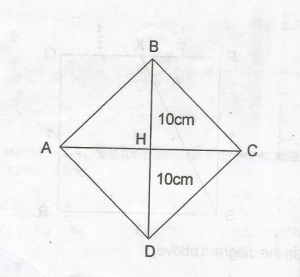A trader bought 100 oranges at 5 for N40.00 and 20 for N120.00. Find the profit or loss percent
20% profit
20% loss
25% profit
25% loss
Correct answer is D
Cost price CP of the 100 oranges = 1005 x N40.00
selling price SP of the 100 oranges = 10020 x N120
= N600.00
so, profit or loss per cent
= SP−CPCP x 100%
= 600−800800 x 100%
= −200800 x 100%
Hence, loss per cent = 25%
215
25
23
45
Correct answer is B
Let x represent the entire farmland
then, 25x + 13[x - 23x] + M = x
Where M represents the part of the farmland used for growing maize, continuing
25x + 13x [1 - 23x] + M = x
25x+13x [35] + M = x
25x + 1x5 + M = x
3x5+M=x
M = x - 25x
= x[1 - 35]
= x[25] = 2x5
Hence the part of the land used for growing maize is
25
4x+5y−xy2xy
5y−4x+xy2xy
5x+4y−xy2xy
4x−5y+xy2xy
Correct answer is D
3x−yxy−2x+3y2xy+12
= 2(3x−y)−1(2x+3y)+xy2xy
= 6x−2y−2x−3y+xy2xy
= 4x−5y+xy2xy
5.0
4.0
3.0
2.5
Correct answer is A

Diagonal |AC| = (2x + 1)cm
In the diagram,area of ΔABC
is 1102 = 12 x |AC| x |HB|
55 = 12 x (2x + 1) x 10
55 = (2x + 1)5
55 = 10x + 5
55 - 5 = 10x
50 = 10x
x = 5010
= 5.0
WAEC Subjects
Aptitude Tests